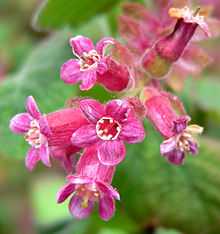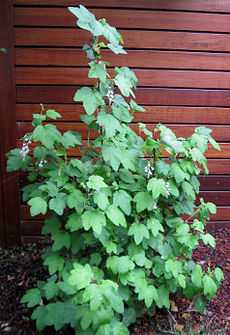Ribes malvaceum
| Ribes malvaceum | |
|---|---|
 | |
| Scientific classification | |
| Kingdom: | Plantae |
| (unranked): | Angiosperms |
| (unranked): | Eudicots |
| (unranked): | Core eudicots |
| Order: | Saxifragales |
| Family: | Grossulariaceae |
| Genus: | Ribes |
| Species: | R. malvaceum |
| Binomial name | |
| Ribes malvaceum Sm. | |

Ribes malvaceum, commonly called chaparral currant, is a member of the Grossulariaceae (gooseberry family). It is native to California and northern Baja California, where it occurs from sea level to 1,500 metres (4,900 ft), in chaparral, foothill oak woodland, and closed-cone pine forest habitats.[1]
Description
Ribes malvaceum typically grows 5–10 feet (1.5–3.0 m) tall.[2] This perennial shrub lacks the characteristic nodal spines which are demonstrated on the stems of many other members in the genus Ribes. The leaf blades (20–50 mm) are densely hairy, glandular, and double toothed.[3]
Infloresences are 10-25 flowered and open, occurring October to April in native range. The hypanthium (5–8 mm) is pink and about twice as long as it is wide. The sepals are pink-purple in color and are 4–6 mm. Petals are 2–3 mm and can range in color from pink shades to white. The flower also contains two fused styles which are fused to the tip and have a hairy base.[3]
Striking glaucous purple berries are produced. The (6–7 mm fruit is glandular and covered by white hairs.[3]
Varieties
There are several varieties of R. malvaceum:
- Ribes malvaceum var. clementinum — (Dunkle) [3]
- Ribes malvaceum var. malvaceum — plants with dark green leaves occurring below 800 metres (2,600 ft).[3][4]
- Ribes malvaceum var. viridifolium — (Abrams) — plants with bright green leaves occurring up to 1,500 metres (4,900 ft) [3][5]
Cultivation
Ribes malvaceum is cultivated as an ornamental plant by specialty plant nurseries. It is used in traditional gardens, native plant landscapes, and as bird food source in habitat gardens.[2] It thrives under oaks in bright dry conditions, and in many other locations.[2][6]
Pollination ecologists have reported the plant important as a honey plant for attracting large numbers of native bees.[2]
See also
References
- ↑ Jepson . accessed 1.23.2013
- ↑ 2.0 2.1 2.2 2.3 Lady Bird Johnson Wildflower Center Native Plant Database—NPIN — Ribes malvaceum . accessed 1.23.2013
- ↑ 3.0 3.1 3.2 3.3 3.4 3.5 Ribes malvaceum in Flora of North America . @ efloras.org . accessed 1.23.2013
- ↑ Calflora.org: Ribes malvaceum var. malvaceum
- ↑ Calflora.org: Ribes malvaceum var. viridifolium
- ↑ Las Pilitas Nursery (natives): Ribes malvaceum, Pink Chaparral currant . accessed 1.23.2013
External links
| Wikimedia Commons has media related to Ribes malvaceum. |
- Jepson Flora Project: Ribes malvaceum
- USDA Plants Database —Ribes malvaceum (chaparral currant)
- CNPS—Cal Flora: Ribes malvaceum (chaparral currant)
- Ribes malvaceum — U.C. Photo gallery